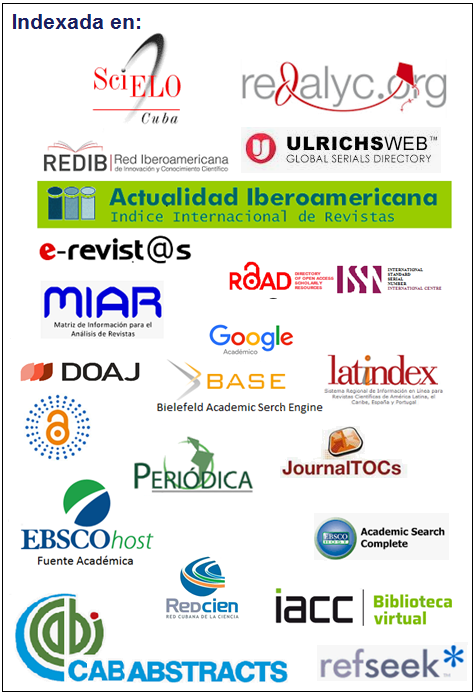Tectonic influence on the spatial arrangement of ore-bearing horizons from San Felipe deposit
Keywords:
San Felipe deposit, tectonics, faulting, nickel-bearing laterite crust, ore-bearing horizon, nickel-bearing mineralization.Abstract
The purpose of the study is to show the influence of tectonic structure on the spatial arrangement and mineralization variability of ore-bearing horizons from San Felipe ferro-nickel laterite crust deposit. Mineral maps content and spatial distribution were prepared from the well log data, and cross sections were made to visualize in depth the displacements produced on both sides of the fault movement vector, and to establish relationships between mineralization and the structural geometry of crust. It is concluded that in this deposit the preservation of ore-bearing horizon is conditioned by the disposition and altimetry of the dislocated rocky substrate because of the tectonic affectation. In the fracture zones, the supergene enrichment with high contents of nickeliferous mineralization is related to the amplitude of tectonic displacements in the altered serpentine from the basement.Downloads
References
Almaguer, Y. 2005: Evaluación de la susceptibilidad del terreno a la rotura por desarrollo de deslizamientos en el yacimiento punta gorda. Tesis doctoral. Instituto Superior Minero Metalúrgico. 87 p.
Ariosa, J., Copa. W. L., Bergues, P. S. Y R. Díaz, R. 2003: Modelo geológico descriptivo para yacimientos lateríticos de Fe-Ni-Co en la faja ofiolítica Mayarí-Baracoa. Minería y Geología, (1-2): 22-24.
Bates, L. & Jackson, J. A. 1987: Glossary of geology. In Groshong, Jr. H. R (2006). 3-D Structural Geology. A Practical Guide to Quantitative Surface and Subsurface Map Interpretation. Second Edition, Springer Berlín Heidelberg New York, 400 pp.
Chang-Rodríguez, A. Y Rojas-Purón, A.L. 2018: Movilidad geoquímica y grado de meteorización del yacimiento San Felipe, Camagüey Cuba. Minería y Geología, 34 (2): 122-135.
Cobas-Botey R.M, Formell-Cortina, F. y Leyva-Rodríguez, C.A. 2017: Modelo geológico descriptivo del yacimiento laterítico San Felipe, Camaguey, Cuba. Minería y Geología, 33 (3):261-275
Drapper, G. & J. F. Lewis. 1983: Petrology and structural development of Duarte complex central Dominican Republic a preliminary account and some tectonic implications In: Duque-Caro, H. Transactions of the Tenth Caribbean Geological Conference, Colombia: Ed. Cartagena, 14th-20th August, 103-112.
Fonseca, E. Zelepuguin, V. Heredia, M. 1984: Particularidades de la estructura de la asociación ofiolítica en Cuba, Ciencias de la Tierra y Espacio, (9):31-46.
Formell, F. 2003: Diferencias en el desarrollo morfoestructural de las regiones metalogénicas exógenas de Oriente Septentrional y Camagüey Central y su influencia en la formación de las cortezas de intemperismo niquelíferas. En: Taller Internacional de la Geología y Minería del Níquel Cubano, TGMNI 02. V Congreso Cubano de Geología y Minería, Ciudad de La Habana, Cuba, 24–28 marzo.
González, E., Cañete, C. Carral, R. Díaz, J. Capote C. y Rodríguez A. 1986: Análisis estructural del macizo Mayarí Baracoa. Serie Geológica, (4) :76-98
Groshong, Jr. H. R. 2006: 3-D Structural Geology. A Practical Guide to Quantitative Surface and Subsurface Map Interpretation. Second Edition, Springer Berlin Heidelberg New York, 400 pp.
Herrington R. J. 1998: Estudio mineralógico de las lateritas niquelíferas del yacimiento San Felipe, Cuba. Museo británico de ciencias naturales. Reporte.
Lavaut-Copa, W. 2004: Patrones de meteorización de rocas ofiolíticas de Cuba Oriental: su importancia para la minería. Minería y Geología, 20 (3-4): 3-14.
Macharé, O. J. 2016: Aspectos-clave de la Geología Estructural para las Exploraciones. Conferencia SEG-UNMSM, Instituto Geofísico del Perú, Universidad Nacional de Ingeniería. [en línea] 66, junio 2016. Consulta 18 ene 2017. Disponible en: http://www.sgp.org.pe
Martínez, A. y Pérez Y. 2000: Metodología para la modelación de yacimientos residuales de níquel. Trabajo de Diploma. Instituto Superior Minero Metalúrgico. 118 p.
Rodríguez-Catalá, A., Ravelo, R. Chang, A. González, R. Y Lugo, R. 2001: Generalización de la información geológica sobre el depósito de níquel San Felipe. En: Proyecto San Felipe Camagüey. Cuba, 47 p.
Rodríguez-Catalá, A. 2005: Reporte de zonas de alta alúmina y diques gabroides en el depósito San Felipe, provincia Camagüey Cuba. [CD-ROM]. En: Iera Convención Cubana de Ciencias de la Tierra - Ier Congreso de Minería - GEOCIENCIAS'2005. Memorias. La Habana, Cuba, 5-8 abril 2005.
Rodríguez-Catalá, A. 2016: La zonalidad litológica del yacimiento San Felipe como patrón de reconocimiento de los cambios progresivos del perfil laterítico. III Congreso internacional de Minería y Metalurgia. MINEMETAL 2016. Memorias 3-7 Octubre Plaza América Varadero, Cuba. Sesión explotación minera EM-1.
Rodríguez-Catalá, A. y Velázquez, L. D. 2018: Comportamiento físico, químico y mineralógico del perfil laterítico San Felipe. Implicaciones para la exploración. IV Congreso internacional de minería y metalurgia. MINEMETAL 2018. Memorias 25-27 Septiembre Plaza América Varadero, Cuba. Sesión técnicas físicas y químicas.TFQ-16.
Tavlan, M., Thorne, R. & Herrington R. J. 2011: Uplift and lateralization history of the Çaldag ophiolitic in the context of neo-tethyan ophiolitic abduction and uplift: implications for the Cenozoic weathering history of western Anatolia. Journal of the Geological Society, 168: 927-940.
Vargas, G. y Rodríguez, A. 2009: Metodología para la prospección de níquel utilizando técnicas de sensores remotos. Boletín Ciencias de la Tierra, 25: 43-46 [en línea] Disponible en: https://revistas.unal.edu.co/index.php/rbct/article/view/10860
Published
How to Cite
Issue
Section
- Authors retain copyright and guaranteeing the right magazine to be the first publication of the work as licensed under a Creative Commons Attribution-NonCommercial that allows others to share the work with an acknowledgment of the work's authorship and initial publication in this journal.
- Authors may establish separate supplemental agreements for the exclusive distribution version of the work published in the journal (eg, place it in an institutional repository or publish it in a book), with an acknowledgment of its initial publication in this journal.
- Authors are allowed and recommended to disseminate their work through the Internet (e.g., in institutional telematic archives or on their websites) before and during the submission process, which can produce interesting exchanges and increase citations of the published work. (See The effect of open access)




